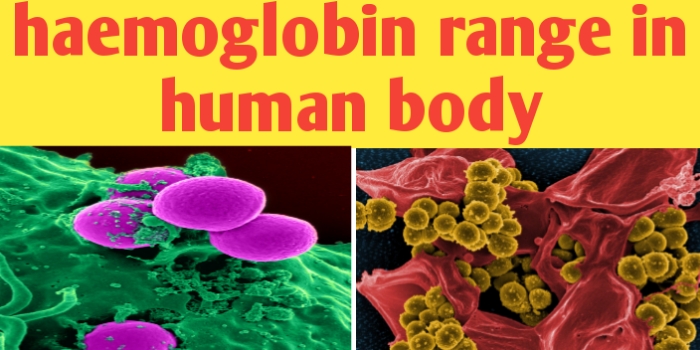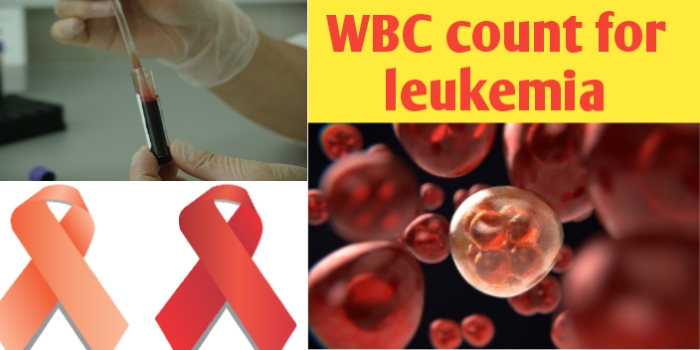Haemoglobin range in human body like female, child, infants
The colour of red blood cell is due to the presence of a solution of iron containing pigment known as haemoglobin and it is represented by Hgb or simply Hb.
In this article we study about hemoglobin range in human body like female, child, infants and adults male. Haemoglobin range is about 15 gram of hemoglobin in 100 ml of blood. And haemoglobin range depends on sexes either it will be male or female, age of male and female, child and infants group and generally haemoglobin range in female during pregnancy low. So haemoglobin range depends on various factors.
Red blood cell erythrocytes carry oxygen bound to to hemoglobin known as oxyhaemoglobin from the lungs via heart to the tissues for oxidation of food to release energy. red blood cells erythrocytes very small amount of carbon dioxide join with haemoglobin to form carbaminohemoglobin and carry it from the tissues via heart to the lungs for removal from the body. So hemoglobin normal range is required in every people of age or group for well functioning of body and carbon dioxide and oxygen transport.
Table of Contents
What is hemoglobin ?
Hemoglobin is the congugated protein. It consists of basic protein known as globin join to a non protein group heme hence the name haemoglobin. Haemoglobin molecule in red blood cells that carries oxygen from the lungs via heart to the body’s tissues and returns carbon dioxide from the tissues via heart back to the lungs, that’s why circulation of blood in human body is double circulation.
◆ Follow me on YouTube
◆ VISIT ON OUR YOUTUBE CHANNEL BIOLOGY SIR FOR MORE VIDEO
Hemoglobin is made up of four protein molecules globulin chains. They are all connected together. The normal adult hemoglobin abbreviated as Hgb or simply Hb. Haemoglobin molecule in red blood cell or erythrocytes contains two alpha-globulin chains and two beta-globulin chains.
In foetus and infants, beta chains are not common and the hemoglobin (Hb) molecule is made up of two alpha chains and two gamma chains only. As the infant grows, the gamma chains are gradually replaced by beta chains and forming the adult hemoglobin structure.
Each globulin chain contains an important non protein part iron-containing porphyrin compound termed as heme. Embedded within the heme compound is an iron atom that is vital in transporting oxygen and carbon dioxide in our blood circulatory system. The iron contained in hemoglobin is also responsible for the red color of blood.
Hemoglobin also responsible and plays an important role in maintaining the shape of the red blood cells. The shape of red blood cells varies in different vertebrate classes in fishes, amphibians, reptiles and birds. they are oval biconvex and nucleated.

Haemoglobin range in human body: female,infants,child and adults
In human beings the shape of RBC are circular biconcave and denucleated disc. Central part is thinner than the margin. Abnormal hemoglobin structure can disrupt the shape of red blood cells and impede their function and flow through blood vessels.
What is hemoglobin normal range ?
Doctors determine your hemoglobin level through blood test that known as complete blood count (CBC) by analyzing a sample of your blood. the variety of factors affect your hemoglobin range including your,age, gender, medical history and keep reading to learn more about what’s considered a normal, high, and low hemoglobin range.
In adults human beings the average hemoglobin range is slightly higher for men than it is for women. And haemoglobin is measured in grams per deciliter (g/dL) of blood. And normal haemoglobin range in human body about 15 g in 100 ml of blood and it is represented as 15g/dL. Where is dL is decilitre which is equal to hundred ml of blood.
Haemoglobin range in human body
Hemoglobin range in human body depends on sex of people either it will be male or female and also its depend on their age. And generally adult female have slightly low content of hemoglobin then male and also haemoglobin level is decrease in older age and during the pregnancy in female.
And hemoglobin level is increased in infants newborn babies. And there is slightly decrease in hemoglobin level in girls due to menstrual cycles and loss of blood in every months And there is chart is given haemoglobin range in human body following:-
● Female infants belongs to the 0 to 30 days age have range 13.4 to 19.9 g/dL and Male infants belongs to the age have normal range 13.4 to 19.9 g/dL
● Female infants belongs to the 31 to 60 days age have range 10.7 to 17.1 g/dL and Male infants belongs to the age have normal range 10.7 to 17.1 g/dL
● Female infants belongs to the 2 to 3 months age have range 9.0 to 14.1 g/dL and Male infants belongs to the age have normal range 9.0 to 14.1 g/dL
● Female child belongs to the 3 to 6 months of age have range 9.5 to 14.1 g/dL and Male child belongs to the age have normal range 9.5 to 14.1 g/dL
● Female child belongs to the 6 to 12 months of age have range 11.3 to 14.1 g/dL and Male child belongs to the age have normal range 11.3 to 14.1 g/dL
● Female child belongs to the 1 to 5 years of age have range 10.9 to 15 g/dL and Male child belongs to the age have normal range 10.9 to 15 g/dL
● Female child belongs to the 5 to 11 years of age have range 11.9 to 15 g/dL and Male child belongs to the age have normal range 11.9 to 15 g/dL
● Female child belongs to the 11 to 18 months of age have range 11.9 to 15 g/dL and Male child belongs to the age have normal range 12.7 to 17.7 g/dL
Haemoglobin range in female
In female haemoglobin content is slightly lower than male. And we know that haemoglobin content is also depends on sex whether it will be male or female. Normal hemoglobin range in female is about 12 g/dL or higher.
And in older female haemoglobin level tend to decrease. This may be due to several factors including, lower iron levels due to chronic inflammation or poor nutrition, medication side effects, high rates of chronic diseases and such as kidney disease.
◆you should also visits our website https://biologysir.com and other website for civil engineer calculation at https://www.civilsir.com
■ follow on YouTube
◆name of fathers in field of Biology
● all full forms of 11th and 12th Biology
Haemoglobin range in adult women is about 12 gm/dL to 16 gm/dL and it is slightly decrease in women of middle age. there is haemoglobin level in women belongs to middle age is about 11.7 gm/dL to 13.8 gm/dL. And also haemoglobin content is decrease in women during pregnancy.
Haemoglobin range in pregnant women during pregnancy
And hemoglobin level in pregnant women during pregnancy is about 8 gm/dL to 12 gm/dL. Pregnant females are advised to avoid both high and low hemoglobin level to avoid increasing risk of still birth due to high hemoglobin content above the normal range and premature birth or birth of low weight baby due to low hemoglobin below the normal range.
Foetus for developing babies totally e depends on Mother’s diet for obtaining nutritional nourishment. And there is is link between what the mothers consumes and the health of the baby is much stronger than once. Eating a healthy food containing varied diet in pregnancy will help to get most of the vitamins and minerals folic acid that are essential during the period of pregnancy including iron.
It is best to get vitamins and minerals from the food, but pregnant women are in need of many supplements food also that are essential to their body as well to their foetus growing including iron and folic acid. Iron is an essential mineral in the pregnancy period for the mother and to the baby as well. Supplementation of pregnant women with iron and folic acid reduces the incidence of anaemia.
During the blood test completed by doctor and their procedure is known as complete blood count (CBC) to diagnose the content of hemoglobin concentration, hematocrit and red cell count. All of these factors RBC count haemoglobin content and hematocrit content fall during pregnancy because the expansion of the plasma volume is greater than that of the red cell mass.
And we know that there is a rise in total circulating hemoglobin directly related to the increase in red cell mass. This in turn depends partly on the iron status of the individual. That’s why pregnant women are recommended to have a hemoglobin level of 12 gm/dL to 16gm/dL and any value below 12 gm/dL is considered as iron deficiency and below 10.5 gm/dL as anemia.
Iron deficient in anemic women have shorter pregnancies or gestation period than non-anemic or even anemic but not iron deficient pregnant women. All anemic pregnant women had a higher risk of pre-term delivery or give birth of pre-mature birth in relation to non-anemic women.
The iron-deficient, anemic group has twice the risk of those with anemia in general. There a five to sevenfold volume increase in premature delivery and low birth weight if the lowest hemoglobin concentration during pregnancy is found.
Haemoglobin range in infants
Infants tend to have higher average hemoglobin levels or range than the adults. This is because they have higher oxygen levels in the mothers womb and need more red blood cells and haemoglobin to transport the oxygen. But this level starts to go down gradually after several weeks when babies start to grow. And there are haemoglobin range in infants charts as follows
● Female infants belongs to the 0 to 30 days age have Haemoglobin level 13.4 to 19.9 g/dL and Male infants belongs to the age have normal haemoglobin level is 13.4 to 19.9 g/dL
● Female infants belongs to the 31 to 60 days age have normal haemoglobin level is 10.7 to 17.1 g/dL and Male infants belongs to the age have haemoglobin normal range 10.7 to 17.1 g/dL
● Female infants belongs to the 2 to 3 months age have haemoglobin range is 9.0 to 14.1 g/dL and Male infants belongs to the age have haemoglobin normal range is 9.0 to 14.1 g/dL
Haemoglobin range in child
Hemoglobin level in child is slightly much less than hemoglobin concentration present in infants, haemoglobin level is about 17gm/dL to 22 gm/dL of newborn babies. And hemoglobin level in child is 11 gm/dL to 13 gm/dL which is also a slightly less than haemoglobin level present in male adult and Adult female.
So haemoglobin range in child (11 gm/dL to 13 gm/dL) is present between infants (17gm/dL to 22 gm/dL) and adult male ( 14 gm/dL to 18 gm/dL and female ( 12 gm/dL to 16 gm/ dL). And there is a haemoglobin range in child chat as follows
● Female child belongs to the 1 to 5 years of age have haemoglobin level 10.9 to 15 g/dL and Male child belongs to the age have haemoglobin normal range 10.9 to 15 g/dL
● Female child belongs to the 5 to 11 years of age have haemoglobin range 11.9 to 15 g/dL and Male child belongs to the age have haemoglobin normal range 11.9 to 15 g/dL.







Leave a Comment